According to the Binh Dinh geographical map, northeast of Quy Nhon City there is a lagoon more than 10 km long and nearly 4 km wide. This lagoon was once called Hai Hac Dam, but for a long time people still called it Thi Nai lagoon. That is the abbreviation of a Cham place name, originally in Sanskrit Cri Vinaya, transcribed in Chinese as Thi-li-bi-nai.
THE LARGEST BALTWATER LAGOON IN THE CENTRAL REGION
Thi Nai is the largest saltwater lagoon in the Central region. Branches of the Kon River and the Ha Thanh River all flow here. The sand gradually accumulates over the years, making the lagoon fuller every day. When the tide rises, the surface of the lagoon is vast, and when there is wind, the waves ripple like the surface of the sea. When the tide falls, the mud is exposed and stretches across the lagoon's surface. Due to the landscape, in ancient books, this place is also called "Dry Sea Lagoon".
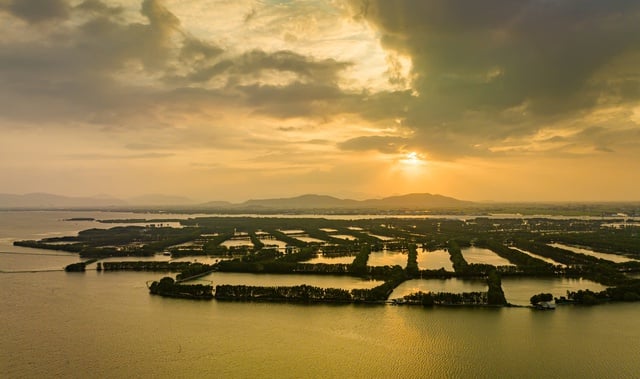
Thi Nai Lagoon is a harmonious combination of forest, mountain and sea landscape.
PHOTO: DUNG NHAN
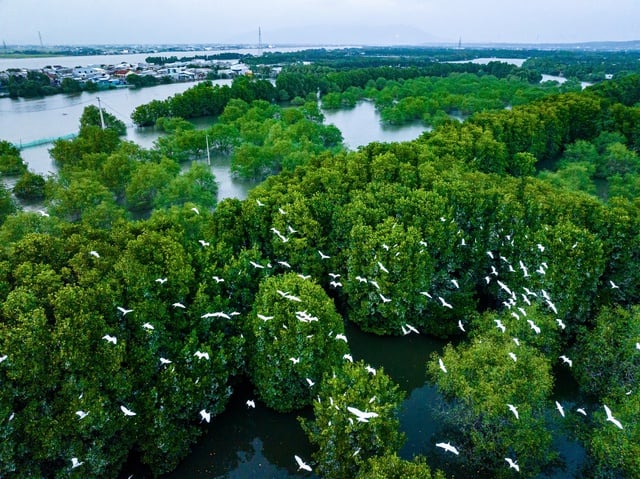
Many birds and storks live in Thi Nai lagoon.
The lagoon water is connected to the sea by a narrow gate called Cua Gia. In ancient Vietnamese, "gia" means sea. Fishing boats often come and go here, hence the name, and for a long time, products of the sea have gone up the Kon River to the mountains to exchange for products there: "Whoever returns to Cua Gia in the evening/ Sends bamboo shoots down, sends flying fish up".
With an area of over 5,000 hectares of water surface, Thi Nai lagoon has a rich ecosystem, many precious flora and fauna and many beautiful landscapes. Of which, the seagrass bed has up to 25 species; the fauna has 64 species of plankton, 76 species of fish; in addition, there are hundreds of species of birds (23 species of waterfowl and migratory birds, 10 species of forest birds)...
In the lagoon, near the west bank, there is a small mountain, on which there is a temple built by fishermen to worship the water god. This temple has the shape of an ancient tower, called Thay Boi Tower.
N FRICTIONAL NAVY BATTLES
For nearly 300 years, from the reign of King Le Thanh Tong to the reign of Lord Nguyen Phuc Thuan, Thi Nai lagoon had calm waves and calm seas. However, the Tay Son - Nguyen Anh war (1787 - 1802) turned Thi Nai estuary into a fierce battlefield many times with battles in the years of Nham Ty (1792), Quy Suu (1793), Ky Mui (1799), Canh Than (1800) and especially the battle in the year of Tan Dau (1801), when Nguyen Anh himself led a large army from the South to attack the Tay Son army stationed at the estuary. The defeat in the naval battle at Thi Nai, the collapse of the mighty Tay Son navy, was one of the direct causes leading to the defeat of the Tay Son dynasty.
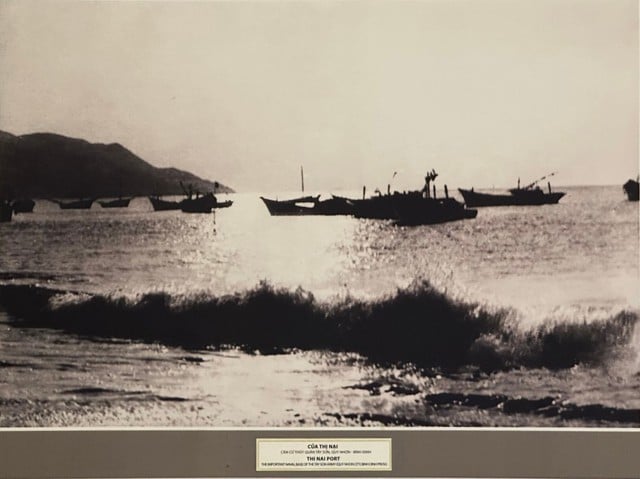
Ancient Thi Nai Gate
PHOTO: QUANG TRUNG MUSEUM
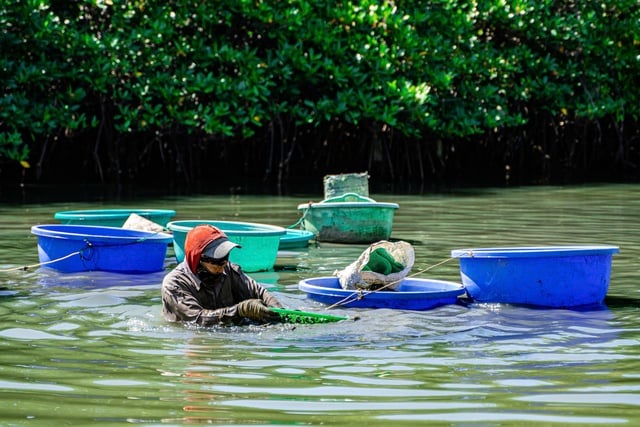
People make a living on Thi Nai lagoon
PHOTO: DUNG NHAN
According to historical documents, in July of the year Canh Ty (1840), King Minh Mang ordered the construction of Ho Co fortress and Thi Nai citadel (defensive works) in Binh Dinh province. In October of that year, when the construction was completed, King Minh Mang issued an edict reminding his mandarins of the role of defense in the estuary area, placing fortresses in Quang Nam, Quang Ngai, Da Nang , Thi Nai, Con Lon, Phu Quoc...
After many changes and ups and downs, Thi Nai lagoon has now returned to its peaceful and tranquil beauty. When visiting Thi Nai estuary, in addition to enjoying the majestic natural scenery, visitors will understand more about a place with many events that have had a profound impact on the country's history. In addition, Thi Nai lagoon is also known for the Thi Nai sea-crossing bridge with a total length of nearly 2.5 km, which used to be the longest sea-crossing bridge in Vietnam.
P COMMUNITY TOURISM DEVELOPMENT
Thi Nai Lagoon is a harmonious combination of forest, mountain, sea landscape and many entertainment and sports services for all ages. This place is strongly developing community tourism.
Rowing a boat to see the landscape and creatures at Con Chim on Thi Nai lagoon brings visitors an unforgettable experience. In particular, at each time of the day, Thi Nai lagoon has different beauty. In the early morning, the scenery is as vast as a fairyland, the clear blue sky blends with the eye-catching forests. In the evening, visitors will be able to fully admire the beauty of the sunset in a space with forests, sea and mountains.
Many tourism experts when surveying Thi Nai lagoon have affirmed that this place is like a "treasure" of Binh Dinh, if exploited properly, it will be a great driving force for the province's tourism industry.
"This is an ideal tourist destination, suitable for backpackers, especially those who love to explore. In particular, coming here we feel the simple, fresh beauty and hospitality of the people here," said Mr. Le Anh Tuan (in Ho Chi Minh City).
According to the planning of Binh Dinh province for the period 2021 - 2030, with a vision to 2050, rapid and sustainable urban development, urbanization becomes an important driving force to promote economic growth, is one of the 5 development pillars of Binh Dinh. And the development and expansion of Quy Nhon city to the northeast, with Thi Nai lagoon as the center has been concretized.
Mr. Pham Anh Tuan, Chairman of Binh Dinh Provincial People's Committee, said that Thi Nai lagoon is a diverse and particularly attractive landscape. Based on the provincial planning, Binh Dinh will exploit and develop this place to become a unique and outstanding highlight that cannot be found anywhere else, with the view of both promoting and preserving existing values. (continued)
Source: https://thanhnien.vn/nhung-tuyet-tac-thien-nhien-dam-thi-nai-bau-vat-cua-binh-dinh-185250517203232724.htm


![[Photo] Party and State leaders visit former President Tran Duc Luong](https://vphoto.vietnam.vn/thumb/1200x675/vietnam/resource/IMAGE/2025/5/24/960db9b19102400e8df68d5a6caadcf6)

![[Photo] Ho Chi Minh City holds funeral for former President Tran Duc Luong](https://vphoto.vietnam.vn/thumb/1200x675/vietnam/resource/IMAGE/2025/5/24/9c1858ebd3d04170b6cef2e6bcb2019e)



























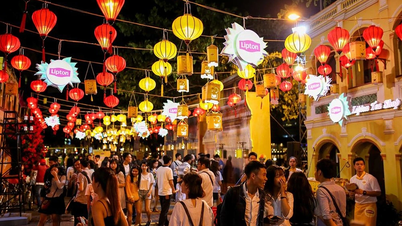
































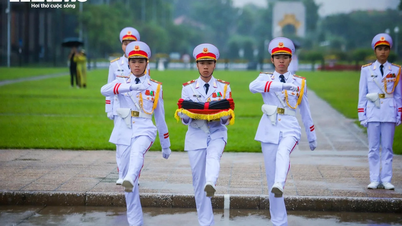








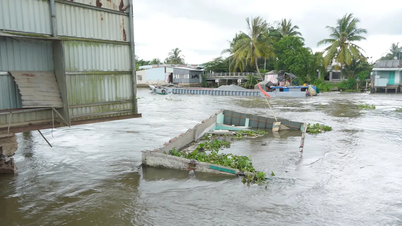





















Comment (0)